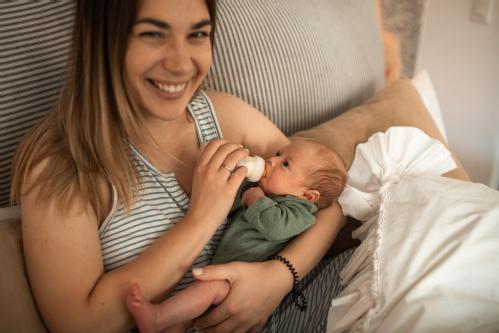Preventing Miscarriages - Embryo Implantation


The way ahead for preventing miscarriages starts by understanding how embryos implant

Professor Jan Brosens, Medical School, Warwick

With one in six pregnancies ending in a miscarriage, every year, 200,000 women experience a miscarriage in England and Wales. Yet, the underlying causes of recurrent pregnancy loss (RPL) have previously been poorly understood. Like most doctors, I entered medicine to make a difference and knew research would be key to informing and changing clinical practice to achieve better outcomes for women and their babies around the world.
RPL is a devastating disorder for many women and their partners and often suffered in silence. Each miscarriage not only increases the risk of further pregnancy losses but also the risk of an adverse outcome in a future ongoing pregnancy, including preterm birth (when a baby is born before 37 weeks). Preterm birth is the single most important cause of neonatal illness and death globally.
After an experience covering the recurrent miscarriage clinic at London’s St Mary’s Hospital, where my first patient suffered seven consecutive miscarriages, I was flummoxed to learn that she conceived each pregnancy within the first cycle of trying. This planted the seed in my mind that miscarriage could be a problem of embryo quality control at implantation, rather than traditionally suspected causes of subclinical disorders that seemingly affect only pregnancy in otherwise healthy women. Even more amazingly, her next pregnancy was successful. I then dedicated my career to exploring and addressing this lack of understanding and clinical need.
I started by examining if the womb lining serves as a biosensor of embryo quality.
Over the ensuing years of research, it became undeniable that an optimal womb lining responds to an implanting embryo in a way that supports the development of high-quality embryos, but actively rejects embryos not fit for nine months of maternal investment1. This selection process is now referred to as the ‘implantation checkpoint.’
We found that in miscarriage patients, the frequency of menstrual cycles without an adequate implantation checkpoint is increased, meaning that high-quality embryos are not supported following implantation, and low-quality embryos are not efficiently rejected. Both scenarios lead to clinical miscarriage and an ability to conceive quickly. With each cycle, the womb lining has a new opportunity to establish a functional implantation checkpoint, which means that many recurrent miscarriage patients do eventually achieve a successful outcome.
However, implantation cannot be studied directly in women for ethical reasons. So, at the University of Warwick, we built sophisticated cellular models. We can now re-grow the womb lining in the 3D cultures using stem cells from individual patients. We can then co-culture these 3D structures with IVF embryos donated to research by couples who have completed their fertility treatment. This means, for the first time, we can observe the early stages of the implantation process in humans directly. This also allows us to screen for drugs that could be effective in preventing miscarriage, crucial for women suffering from RPL.
The focus of my work now is developing new tests and treatments for the prediction and prevention of miscarriage. A new test, called the ‘digital endometrial function test,’ will shortly be launched in the Implantation Research Clinic at University Hospitals Coventry and Warwickshire. We have also completed pilot-trial studies on new drugs for miscarriage prevention2 and are nearing the completion of a large clinical trial assessing the value of antibiotics in women suspected to have chronic womb inflammation. The direction of travel is clear to me - rather than giving medication during pregnancy in the hope that you can prevent a miscarriage, the emerging therapies will be given before pregnancy to ensure that the womb lining is optimal at the time of embryo implantation.

This research has its challenges, including convincing research councils and charities that our investigations deserve funding. An important milestone was the launch of the Tommy’s National Miscarriage Research Centre in 2016. The Centre brings together researchers with different expertise in miscarriage research from the University of Warwick, the University of Birmingham, and Imperial College London. Tommy’s enabled us to address multiple areas of unmet need comprehensively, ranging from basic molecular and cellular studies to addressing the psychological impact on couples affected by recurrent miscarriage, execution of large clinical trials, improving clinical guidelines and advocating for patients.
I believe this research is helping a huge number of women and their partners attending our Tommy’s clinics. The Centre has also been instrumental in breaking the silence, stigma, and lack of information around miscarriage as well as specialist training for healthcare providers; issues that were recently debated in parliament. I hope that as a result of this continued research, emerging treatments that optimise the womb lining before pregnancy will not only prevent miscarriage but also reduce the incidence of other pregnancy disorders, including preterm birth.
1Maternal selection of human embryos in early gestation: Insights from recurrent miscarriage. Brosens JJ, Bennett PR, Abrahams VM, Ramhorst R, Coomarasamy A, Quenby S, Lucas ES, McCoy RC.Semin Cell Dev Biol. 2022 Jan 27:S1084-9521(22)00015-5. doi:10.1016/j.semcdb.2022.01.007.
2Impact of sitagliptin on endometrial mesenchymal stem-like progenitor cells: A randomised, double-blind placebo-controlled feasibility trial - eBioMedicine (thelancet.com)
Related article
warwick
